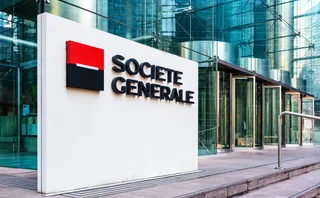
Hedge fund wizard aims to sweep up
Marco Avellaneda likes to be both an entrepreneur and an academic thinker. His latest venture, the Paris-based Nimbus volatility arbitrage hedge fund, allows him to span both worlds.

It was inevitable that Marco Avellaneda would end up moving full time into the hedge fund world. The former New York University (NYU) finance professor, who has just moved to Paris to set up a hedge fund at alternative investment specialist Capital Fund Management (CFM), has always, throughout his distinguished academic career, kept close to Wall Street.
“Wall Street has always allowed me to take my latest idea and apply it,” he says.
Avellaneda’s latest venture, the Nimbus fund (it’s the name of Harry Potter’s make of broomstick, if you thought it sounded familiar), again lets him strike a balance between theory and practice. The fund, which is due to launch sometime in the third quarter, will focus on equity volatility arbitrage and will aim to achieve de-correlated returns from options mispricings.
It will trade a portfolio – composed of the 100 most liquid S&P 500 stocks – of long and short-listed equity options together with long and short underlying stock positions. CFM also runs the Discus fund, a managed futures programme, and Ventus, an equity long/short statistical arbitrage fund.
“We’re talking about bringing volatility as an asset class to the alternative investment community,” says Avellaneda, “and the work we’re doing now is simply trying to put that on a firm setting.”
For the moment, that means setting up the trading model and putting in place the appropriate systems to run it, while also marketing the fund to draw in capital from the US and Europe. Avellaneda’s academic background and broad expertise across quantitative research, trading and systems meant he was ideal for the role.
Excited
The son of an Argentine diplomat, he was raised in Rio de Janeiro, Buenos Aires and Paris. As well as English, Avellaneda speaks fluent Spanish, French, Portuguese and some Italian. He went to university in Buenos Aires before going on to the University of Minnesota to do his PhD, which he finished in 1985. At this point he thought about going to work on Wall Street but decided he was “more excited about science”, so took on a post-doctoral position at NYU instead.
As the derivatives markets began to take off in the late 1980s and early 1990s, Avellaneda started to take serious academic interest in options theory. He says, “In 1993, I began giving a class [on derivatives pricing], and all these people were coming from different banks. I had a 50-person class in 1994, and they just kept coming.”
Since 1987, Avellaneda has published 90 papers. There have also been books, including, in conjunction with the University of Rome’s Peter Laurence, Quantitative Modelling of Derivative Securities: From Theory to Practice, published in 1999. Avellaneda is managing editor of the International Journal of Theoretical and Applied Finance, and upon leaving NYU was director for the division of financial mathematics at the Courant Institute of Mathematical Sciences – he co-founded its masters programme in mathematics and computation in finance.
His consulting work over the years has been varied, from providing independent pricing and analysis of an employee stock option plan for a Mexican petrochemical company, to studying arbitrage opportunities in forward freight agreements for a freight derivatives dealer and advising quantitative research teams on new pricing models at swaps dealers.
“The more we advance, the more the line between business and research becomes increasingly blurred,” he says. “My background always made me more suited to the research side, and I had to learn to transition to having more of a business focus.”
On leave from NYU, he spent a little over a year, from late 1996 to early 1998, as vice-president in the derivatives products group at Morgan Stanley Dean Witter. “It’s much more interesting to work on models that actually get traded right away,” he says.
Until his recent appointment, and from 2001, Avellaneda advised Gargoyle Strategic Investments on its volatility trading fund. Prior to this point he had really been focused on the over-the-counter market, and his work at Gargoyle showed him what could be achieved with listed equity options and index options in terms of relative-value trading.
With his vast experience across business and academia, Avellaneda could have gone anywhere – head of quantitative research at one of the big trading houses, a software company, or perhaps he could even have capitalised on his own modelling and computer expertise by setting up a business to sell trading software – so why the move to CFM?
“All arbitrage ideas in the market eventually don’t work anymore. But if you have a really good research team then you can always come up with the next idea. The situation here is that we rely on people’s creativity to always be ahead.”
And although he will always maintain strong links to the academic community, and especially NYU, the ivory tower is not the place for Avellaneda. “I like to see my work applied,” he says.
Only users who have a paid subscription or are part of a corporate subscription are able to print or copy content.
To access these options, along with all other subscription benefits, please contact info@risk.net or view our subscription options here: http://subscriptions.risk.net/subscribe
You are currently unable to print this content. Please contact info@risk.net to find out more.
You are currently unable to copy this content. Please contact info@risk.net to find out more.
Copyright Infopro Digital Limited. All rights reserved.
As outlined in our terms and conditions, https://www.infopro-digital.com/terms-and-conditions/subscriptions/ (point 2.4), printing is limited to a single copy.
If you would like to purchase additional rights please email info@risk.net
Copyright Infopro Digital Limited. All rights reserved.
You may share this content using our article tools. As outlined in our terms and conditions, https://www.infopro-digital.com/terms-and-conditions/subscriptions/ (clause 2.4), an Authorised User may only make one copy of the materials for their own personal use. You must also comply with the restrictions in clause 2.5.
If you would like to purchase additional rights please email info@risk.net
More on People
People: SocGen and Nomura spot slew of FX hires, RepoClear gets new head, and more
Latest job changes across the industry
People: All fall in at Citi, TD turbulence, and more
Latest job changes across the industry
Asia moves: senior hires at Citi, BNP Paribas, and more
Latest job news from across the industry
People: Masters moves into FNZ, Two Sigma founders step back, and more
Latest job changes across the industry
Cardano’s Max Verheijen moves to BasisPoint
Verheijen spent 24 years at the Dutch pension advisory firm
People: SocGen’s Farah replaces Salorio, Deutsche makes credit hire, and more
Latest job changes across the industry
Coex Partners hires former Citi head of FX Apac sales
Matt Long joins Coex in Singapore to oversee FX execution and trading strategy for regional clients
Athora CFO exit caps management overhaul
Entire management team at Apollo’s European insurance affiliate has been replaced since 2022







